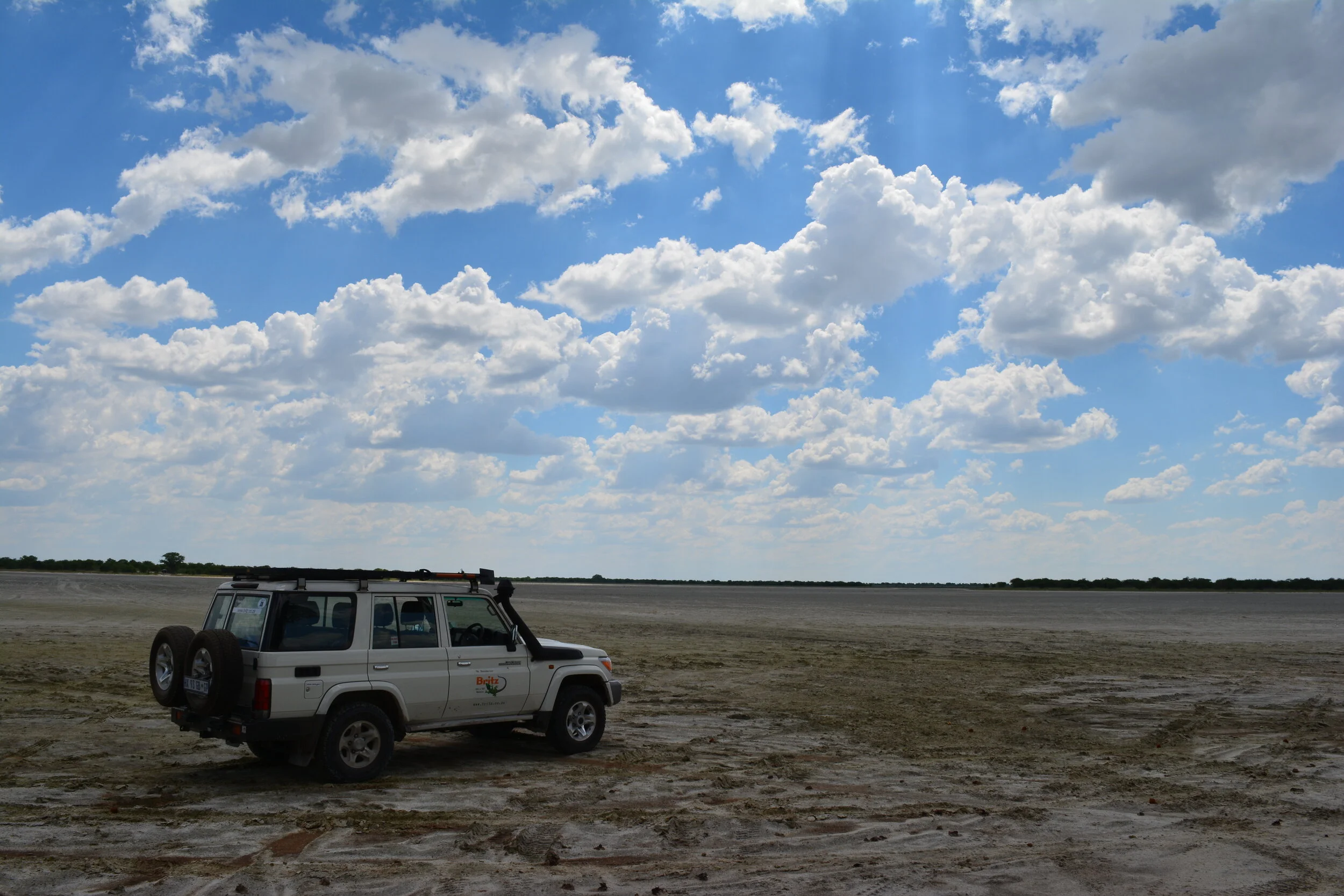The cracked expanse of brittle, sandy mud stretched to the horizon. Like a petrified sheet of shrink wrap the crisp veneer clung tautly to the surface of the northern Kalahari Desert. Once a vast, inland lake thriving with life, this salt pan was now barren under a parching sun, raked by hot wind. In a week or two the rains would return, grass would sprout, and a sheen of water would cover the flat plain again – until the following dry season. For today, during my brief touch, it was a sweeping immensity of crumbly mud.
In these conditions the Kudiakam Pan is a hauntingly beautiful landscape. Almost a roadside attraction on the way to the main event in the Nxai Pan National Park in northern Botswana, I found it even more captivating than the wildlife-rich plains in the more remote reaches of the park. From the main access route running north-south through the park a drive along 12 kilometers of loose, sandy track leads east to the fringe of the pan.
A a narrow track leads through a sea of grass heading east off the main route. Photo by Nicholas Bratton.
Approaching the verge of desiccated mud I paused and gazed across the shallow crater that lay ahead. The track vanished into the featureless plain. I hopped out of the Land Cruiser to scout the next move. I understood the risks of traversing this terrain and wanted a closer look at what came next. Although the pan appears to be solid, the strength of its surface can be inconsistent. A vehicle can unexpectedly break through the crust and sink to its frame in heavy mud beneath, making recovery difficult at best, impossible if you are alone like we were. The least perilous strategy is to drive on existing tire tracks where repeated passage has compacted the surface. In the dry conditions of late December this was a relatively safe bet. Later in the rainy season this route would be impassable.
The transition between grass plain to the sand-mud mixture of a satellite pan en route to Kudiakam. Photo by Nicholas Bratton.
This particular portion of the pan was only a few hundred meters wide. Across the plain I spotted a gap in the grass where the track resumed. A direct line between here and there would be the least problematic route. Staying in four-wheel drive – high range – I locked the rear differential for purely superficial reassurance and eased onto the pan, feathering the throttle to avoid stressing the surface. The mask of dried mud crackled beneath our tires. We crossed this peripheral lobe of the pan with no drama and rejoined the sandy track for the final stretch through grassland to the Baines baobabs.
The cluster of trees was a minor anticlimax. It was heavily traveled, the area around the trees eroded underfoot from throngs of visitors like us. The trees themselves bore disappointing but unsurprising signs of human abuse, names and symbols carved into the trunks of these thousand-year old sentinels. Impressive as it was, this grove of massive parapets towering over the edge of the Kudiakam Pan didn’t hold my interest for long. After traversing the Avenue of the Baobabs at sunset in western Madagascar, other groups of these majestic ancient trees feel like gangs of punk teenagers in comparison.
A 3,000-year old baobab. Photo by Michael Bratton.
I turned my gaze across the main expanse of the Kudiakam Pan. The emptiness was inviting. The sense of space and solitude drew me onto the friable façade to feel the scale of the landscape. The fragility of survival in this desert came into focus beneath the piercing sun. Human presence in this domain was like touching a hot pan on the stove – more than a quick brush and you would burn. But for that fleeting instant the heat and the isolation were deeply satisfying. The dry plains appeared inhospitable but the environment was rich, the great void creating volume to replenish the spirit in a near-pristine environment.
View from the edge of the Kudiakam Pan. Photo by Nicholas Bratton.
The return journey to the park entrance was interrupted by a couple encounters with elephants. I spotted four of them ahead on the grassy track and reversed the Land Cruiser as they continued to approach. After a hundred meters of backing away from them, the quartet struck off to the north and we advanced after they had wandered well away from the track. Later we saw a lone bull drinking from a mud puddle in one of the satellite pans and we waited for ten minutes until it lumbered off before we crossed to the other side. Kudiakam Pan was a peaceful and beautiful area. It has three remote campsites that would be ideal spots for enjoying an extended visit. One day was insufficient to appreciate the magnitude of its allure.


